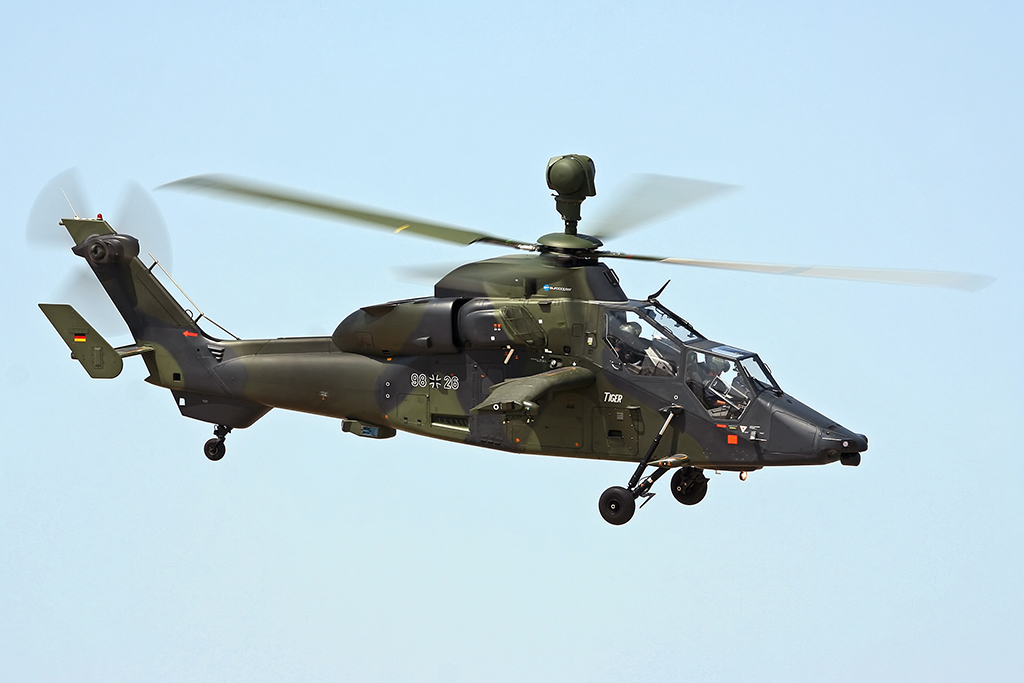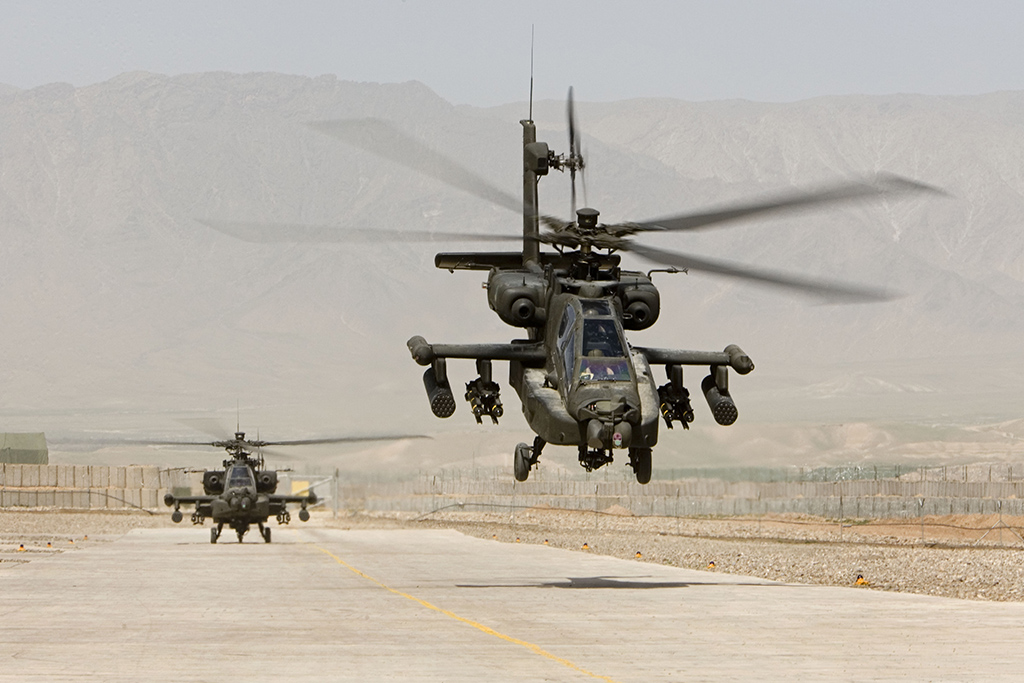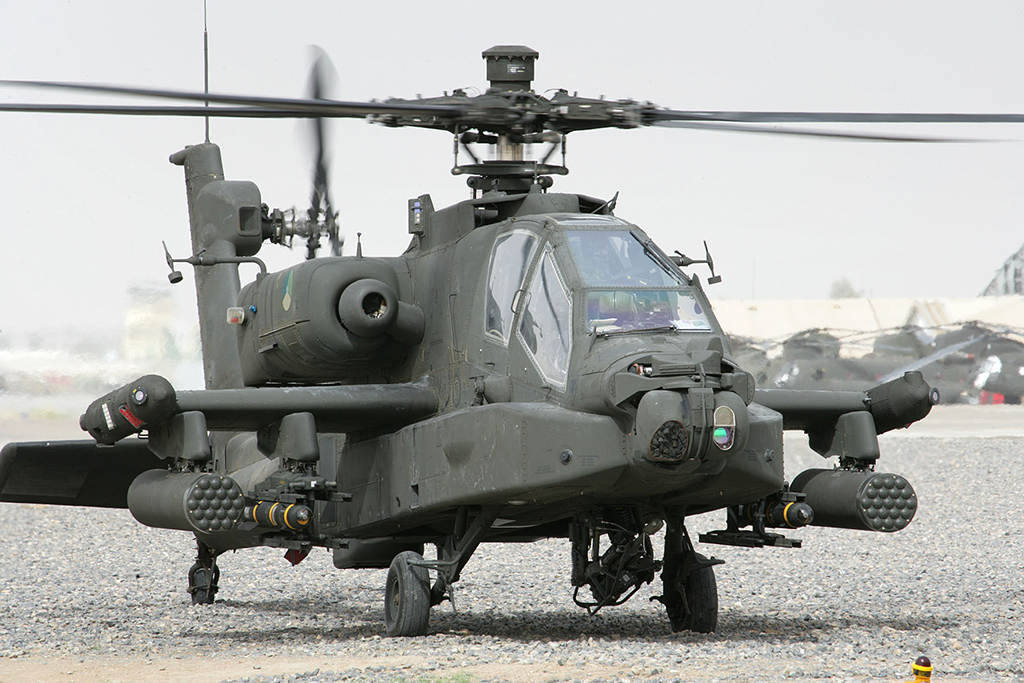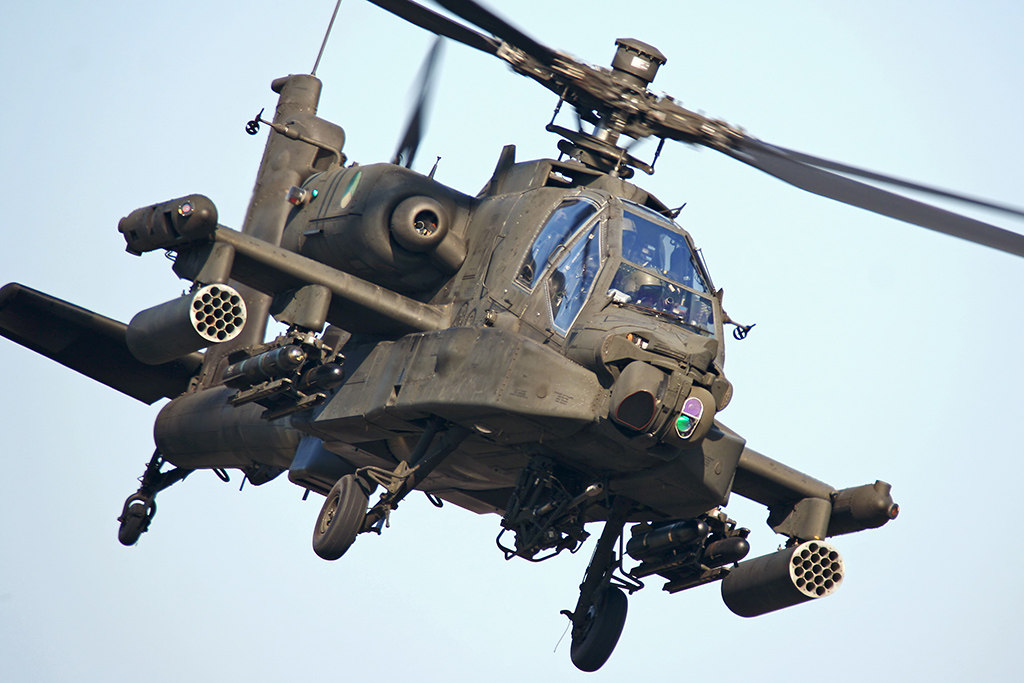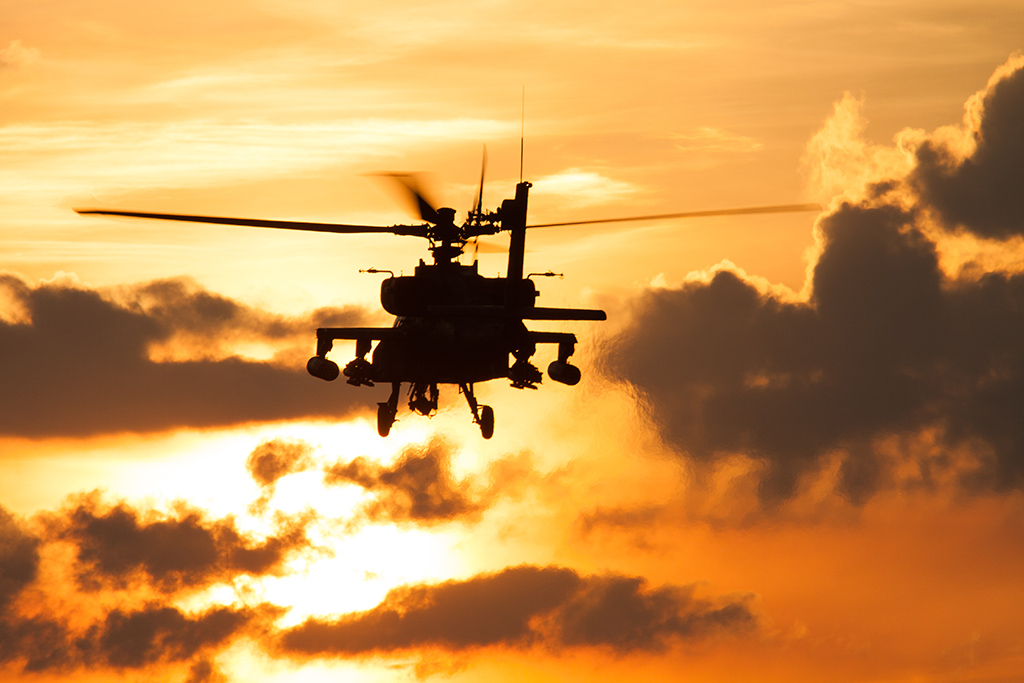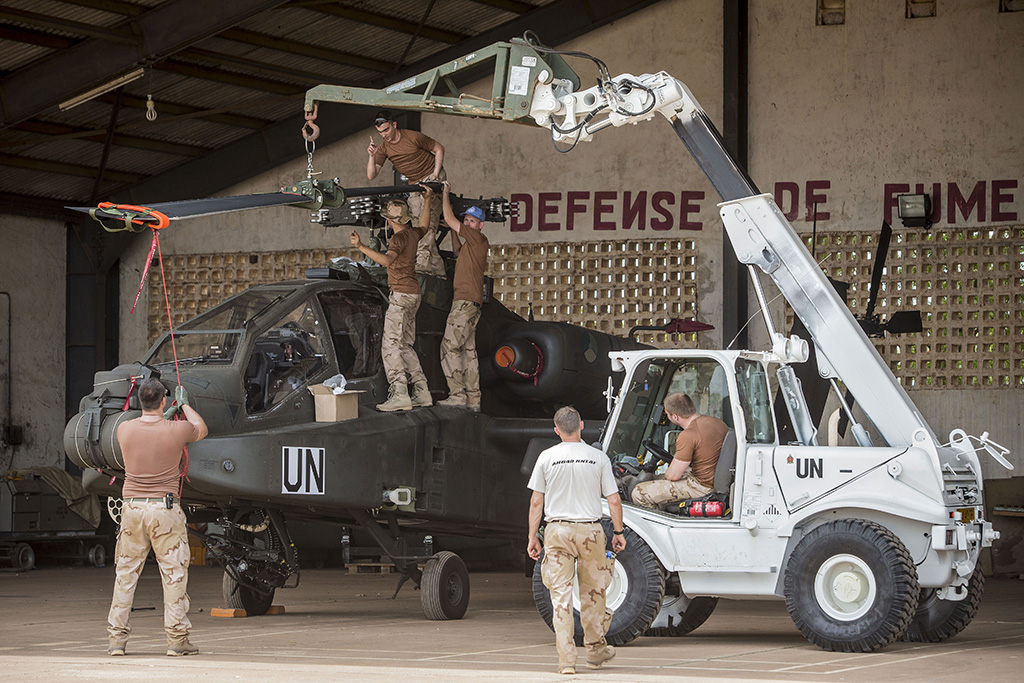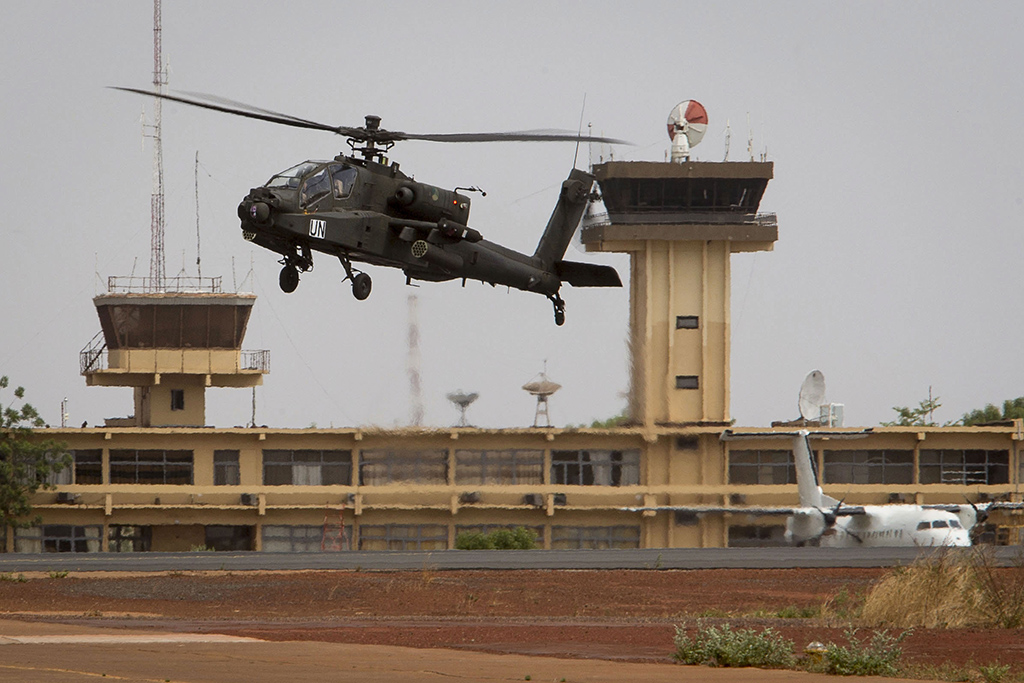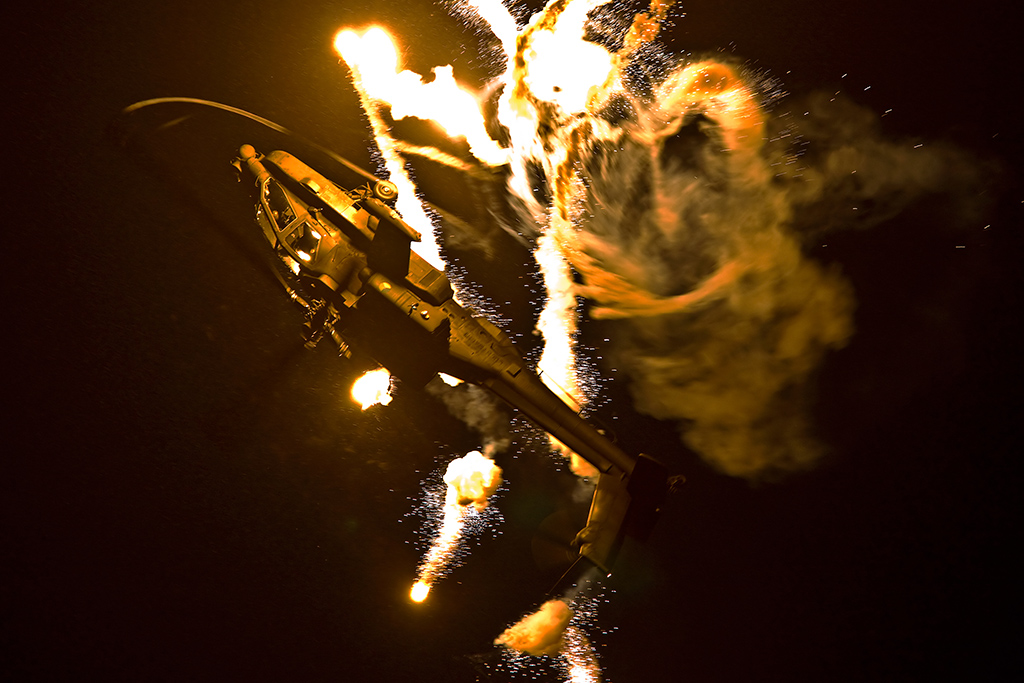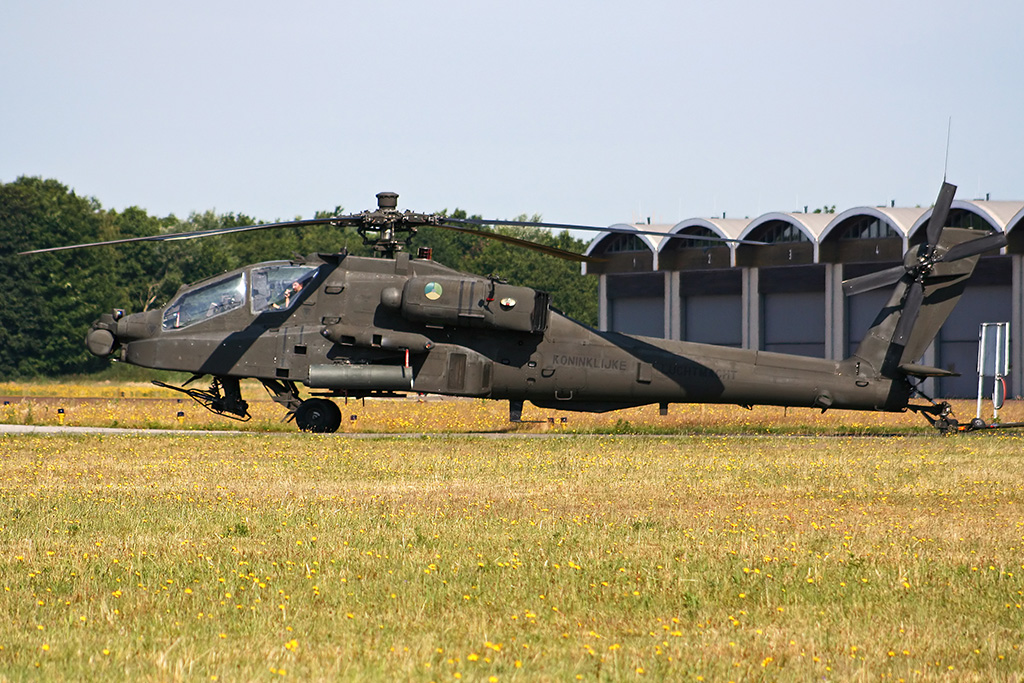In May 1995, the Netherlands Ministry of Defense (MoD) signed a contract to buy 30 Boeing AH-64D Apache helicopters. Next year, the attack helicopters serves 20 years with the Royal Netherlands Air Force (RNLAF). Originally the Apache was designed to eliminate tanks and other armored ground targets. But, due to its wide armament and sophisticated reconnaissance equipment the helicopter is very versatile. The RNLAF Apache proved its use during several deployments to crisis situations abroad since 1998, such as in Bosnia and Afghanistan.
Purchase
In July 1974, the Netherlands government determined her new defense policy. Besides several reductions within the Netherlands Armed Forces the Defense White Paper stated the need for armed anti-tank helicopters against the preponderance of tanks that NATO faced in the event of a Soviet attack. However, the Dutch government first gave priority to modernize land-based weapon systems.
The 1991 Defense White Paper was a turning point. This paper stated the need for a more flexible army. The Dutch infantry brigade was to be transformed into an airmobile brigade. Such a brigade was supposed to be able to effectively respond to the diffuse range of threats that arose after the end of the Cold War. It was eminent that the brigade had to be well equipped with combat and transport helicopters.
After setting the operational need for an attack helicopter, studies started to determine which type would be the best match for the designated tasks: reconnaissance, armed escort, protection and armed air support. At first, the Bell AH-1 Super Cobra and the Agusta A129 Mangusta together with the Eurocopter Tigre were possible candidates. Ultimately, the Netherlands MoD chose the Apache over the Tigre because the Apache is able to perform all of the mentioned tasks simultaneously and at the time became available sooner than the Tigre.
The contract to buy the Apache D-model was signed on the 24th of May 1995. Delivery of the 30 helicopters to the RNLAF began in May 1998. In the meantime, the Netherlands MoD leased 12 United States Army AH-64As until February 2001. The last D-model was delivered to the RNLAF in May 2002.
Defense Helicopter Command
The Netherlands Armed Forces currently operate four types of helicopters, all serving with the RNLAF Defense Helicopter Command (DHC). Colonel-pilot Pier Schipmölder is the DHCs Chief of Staff. The colonel is a very experienced pilot and has clocked about 1,700 flying hours on the attack helicopter. He is responsible for the daily operations, the coherence of the assignments and is the first advisor the DHCs Commander, Gerhard Polet. The colonel explains about the DHC: "The Netherlands MoD conducted a study during the '90s called the Integrated Military Helicopter Capacity. The study looked at the possible establishment of a defense-wide helicopter command, combining military aviation, airmobile and maritime helicopter operations. The reasons for this study were the need for cost-and staff cutting measures within the Netherlands Armed Forces while at the same time the demand of deployment for helicopters grew. The study led to the foundation of the DHC on the 4th of July, 2008. Within DHC all (helicopter) operations are carefully and fully weighed. Even though the DHC is spread over three bases, our organization and our procedures have proven to be very effective."
DHC fleet
Besides the Apache, the DHC operates the NH Industries NH-90, the Eurocopter AS532U2 Cougar and the Boeing CH-47D/F Chinook. The colonel: "We operate the NH-90NFH (NATO Frigate Helicopter) from Naval Air Station De Kooij. The other RNLAF helicopters are operated from Gilze-Rijen Air Base (AB). Today, 20 of our Apaches are stationed there with the 301 Squadron and eight are stationed with the 302 Squadron at Robert Gray Army Air Field, Fort Hood, United States of America. There the Apache (and Chinook) pilots are educated and trained. Also the Military Aviation Terrain Deelen (MATD) resorts with the DHC. MATD is not an active airbase, but large parts of the former Deelen AB are used as a training area." Besides the mentioned squadrons, DHC also has units for education of loadmasters and door gunners, a maintenance squadron and a base squadron which is responsible for platform tasks, such as air traffic control and the fire department.
Longbow Apache
The prototype of the AH-64, designated as YAH-64, made its maiden flight in 1975. Further development and production by Boeing Defense & Space Industries started in 1977. The first Apaches, designated as AH-64A, were delivered to the United States Army in 1983.
The AH-64D is a modernized and updated version of the A-model and was manufactured from 1997 and on. The most important differences between the A- and the D-model are the Target Acquisition and Designation System (TADS), a fully integrated digital cockpit and an Integrated Helmet And Display Sight System (IHADSS) which makes the images of the TADS and Forward Looking Infra-red Radar (FLIR) visible in the pilots' helmets. Furthermore, the D-model is powered by the improved T700-GE-701C engines and can be equipped with the AMASE-system (Apache Modular Aircraft Survivability Equipment, an upgrade of the infrared missile protection systems). The RNLAF D-model can fire 16 AGM-114A Hellfire II and 76 Hydra 70 air-to-ground missiles and has an Hughes M230 Chain Gun which can hold 1,200 30 millimeter bullets.
The only real difference between the RNLAF D-model and the D-model used for example by the United States Army and the English Army Air Corps is that the Netherlands Apaches are not equipped with the Fire Control Radar (FCR). The FCR is normally mounted on top of the main rotor with a rotor-mast-mounted drum. This very noticeable radar led to the unofficial nickname 'Longbow Apache'. Nevertheless, all RNLAF D-models are considered Longbow Apaches too.
Deployments abroad
The Apache is very versatile due to its wide armament and sophisticated reconnaissance equipment. Because crews can perform several different tasks simultaneously with the helicopter, the RNLAF Apache proved to be ideal to deploy to crisis situations all over world. The first deployment to a crisis situation was Bosnia. Colonel Pier Schipmölder was deployed to all the crisis situations the RNLAF Apache was active in, seven times up until today.
SFOR
One month after delivery of the first Apaches to the RNLAF, the Dutch government decided to take part in the SFOR with its new gunship. The colonel's first tour was to Bosnia. "From there our helicopters were used mostly for reconnaissance- and security missions, such as detecting weapons storages and protecting SFOR-units. Within NATO it took some time to get adjusted to the fact that our helicopters flew with the air force, instead of with the army as is the case with most armed forces within NATO. Besides a slight difference in cultures between air and ground forces, also the command structure differs. But, as we were all on the same mission, those slight differences quickly disappeared and we operated as one team", he says.
The Bosnian civil war (1992-1995) erupted because of the disintegration of the Socialist Federative Republic of Yugoslavia. The war began when Bosnia and Herzegovina declared its independence in 1992. The war officially ended with the General Framework Agreement for Peace in Bosnia and Herzegovina, or Dayton Agreement. This agreement divided Bosnia and Herzegovina into two entities: the Federation of Bosnia and Herzegovina and the Serb Republic. NATO led the Stabilization Force (SFOR) which oversaw compliance with the Dayton Agreement between 21st of December 1996 and the 2nd of December 2004. Between the 17th of June 1998 and the 17th of September 1999 two RNLAF Apaches were deployed at the so-called Comanche Air Base near Tuzla, Bosnia. During that period in total five Apache detachments were deployed, flying over 650 hours during 332 missions.
UNMEE
After Eritrea gained independence from Ethiopia in 1991, disputes between the two African countries about the exact boarder limits started. A serious dispute in 1998 led to a war between both countries, resulting in tens of thousands of casualties and hundreds of thousands of people fled the area of the dispute. In June 2000 both countries signed a cessation of hostilities agreement following proximity talks led by Algeria and the Organization of African Unity. With resolution 1312 the United Nations Security Council (UNSC) decided in July 2000 to set up the United Nations Mission in Ethiopia and Eritrea (UNMEE).
UNMEE was aimed at maintaining liaison with the parties and establishing a mechanism for verifying the ceasefire. The UNSC authorized UNMEE to monitor the cessation of hostilities and to help ensure the observance of security commitments. After already deploying four Chinook helicopters to the Horn of Africa, the Dutch government decided on the 18th of October 2000 also to deploy four Apache helicopters. These were stationed in the Republic of Djibouti. Because of the distance to the area in which UNMEE was active, the RNLAF helicopters only came into action during planned evacuation operations or when occurring incidents called for Apache support. The detachment returned to the Netherlands on the 26th of June 2001.
ISAF
On September 11th, 2001 Al-Qaeda attacked New York and Washington DC. Invoking Article 51 of the United Nations Charter (the right to self-defense) the USA declared war on terrorism and together with other NATO-allies attacked the Taliban government that hosted Al-Qaeda and its leader Osama bin Laden in the north of Afghanistan. This Operation Enduring Freedom meant the first phase of the International Security Assistance Force (ISAF, participating NATO-members).
The RNLAFs participation in ISAF started on the 6th of April 2002 initially with their KDC-10 tanker aircraft and C-130 transport aircraft. Six Dutch Apaches entered ISAF in April 2004. Schipmölder: "Flying from Kabul International Airport (IAP) we used our Apache helicopters mostly for air reconnaissance, escort tasks and protection of land convoys, transport helicopters or Medevac flights (medical evacuations). We also used our Apaches to create peace and stability by showing ISAFs force and prevalence."
15 Years after the Apache entered service, the RNLAF suffered her first loss of this helicopter. During the ISAF period, on the 29th of August 2004 the Apache with serial Q-20 crashed during a routine flight from Kabul to Bagram. The crew survived and suffered only light injuries, but the airframe was written off.
Between April 2006 and November 2010 five Apaches were active in ISAF, flying from Kandahar Air Field. The helicopters protected forces serving under the 1st Air Task Force Uruzgan, which assisted in the reconstruction of the Afghan province. The reconstruction resulted, amongst other achievements, in the establishment of an Afghan National Police and the built of an hospital in Tarin Kowt, over 150 medical posts in the province and several schools. Between 2006 and 2010 the Apaches made more than 1,200 flights clocking over 7,000 hours.
SFIR
In the meantime, in March 2003, the USA and the United Kingdom started a war against Iraq. The aim was to bring down Saddam Hussein's reign. Hussein (supposedly) suppressed the Iraqi population, supported international terrorism (amongst others Al-Qaeda) and developed, owned and deployed weapons of mass destruction. The Iraq War lasted officially until the 1st of May 2003. Three weeks later the UNSC adopted resolution 1483, which provided for the establishment of a stabilization force in Iraq (SFIR). SFIR had to assist the Iraqi people with rebuilding their country, reform public authorities and create stability and security. On the 25th of May 2004, the first three of six Apaches departed to Iraq. The other three arrived in June. The Apaches were added to the already consisting RNLAF helicopter SFIR-detachment at Tallil AB. From then on a total of 12 RNLAF Apaches (six ISAF, six SFIR) were active in the region. The Apaches participating in SFIR were used to support the peacekeeping mission in the Al-Muthanna province, by creating stability and security during the rebuilding phase of Iraq. The Dutch participation in SFIR lasted until March 2005.
MINUSMA
The United Nations Multidimensional Integrated Stabilization Mission in Mali (MINUSMA) was established by UNSC resolution 2100 of the 25th of April 2013 to support political processes in that country and carry out several security-related tasks. The mission was asked to support the transitional authorities of Mali in the stabilization of the country and implementation of the transitional roadmap. By unanimously adopting resolution 2164 of 25 June 2014, the Council further decided that the mission should focus on duties such as ensuring security, stabilization and protection of civilians, assisting the reestablishment of state authority, the rebuilding of the security sector and the promotion and protection of human rights in that country.
Between May 2014 and January 2017 four RNLAF Apaches operated from the small city of Gao, in the east of Mali, collecting intelligence and protecting Dutch and UN personnel in the area. On the 17th of March 2015 one the Dutch gunships (serial Q-15) crashed during a shooting exercise killing both pilots. Besides Apaches the RNLAF also deployed three Chinook transport helicopters to Mali. These returned in March 2017.
"There's a big difference between UN-led and NATO-led operations", Schipmölder says. "Obviously, the civilian UN-organization differs greatly from military organizations. Even though UN-led missions as well as NATO-led mission are primarily focused on saving human lives and restoring stability in a crisis area, the economic aspects of operations are far more important when conducted under UN-flag. I remember well that for all operations conducted under UN-flag, such as MINUSMA, our business had to be in order. For example, we had to account for our planning in advance and routes flown, procedures followed and fuel used after our flights. If we wanted to deviate from UN-standards, then the UNSC in New York had to decide about that. In military-led operations those aspects are important too, but ultimately are just the means necessary to gain a certain military effect. Well-motivated deviations from standards when needed is easier when a mission is led by NATO. Obviously because operations are handled primarily from a military point of view and our chain of command is shorter."
Solo Display Team
The Apache Solo Display Team together with the F-16 demo team are the two official demonstration teams of the RNLAF. The teams are used to promote the RNLAF during national and international airshows. The RNLAF is the only air force in the world which has a demonstration team flying the Apache. Other Apache demonstrations in the world are performed only by pilots of the Boeing company.
Because of operational deployments the team didn'tperform any shows between 2005 and 2009 and in 2012, but did in 2010 and 2011 and between 2013 and 2016. In 2017 the demo team will not demonstrate the Apache. The RNLAF decided that her personnel need time to rest and train after being deployed to crisis situations for 20 years in a row.
The future
The current RNLAF Apaches are Block I configured. Colonel Schipmölder says: "The helicopter has some limitations to current standards. For example, it is not possible to receive or send photo or video images. The improved Apache, the Block II configuration, is capable of this. Furthermore, the Block II has improved computer technics which makes the use of digital 3D maps possible. The RNLAF has decided to improve its fleet of attack helicopters and all its Apaches should be Block II configured in 2018." For the future, the RNLAF is studying the possibilities to modify its Apache fleet to the E-model. Schipmölder explains the difference between the D- and E-model: "The E-model overcomes a whole generation of technology. It has an advanced combustor, improved turbine cooling techniques, new crystal turbine nozzles and an advanced thermal barrier coating. The most important improvement however is that the E-model can communicate with other NATO-assets, even Unmanned Aerial Vehicles, through the Joint Tactical Information Distribution System. This system is comparable to the well-known LINK-16 system. Furthermore, the rotor blades are made of composite, are six inches longer and have a new tip design for improved aerodynamics." The decision to convert the D-model into E-model could already be made in 2021.
Even though Apache crews need to be trained frequently, it's not always possible to fly extra or even sufficient training missions. Schipmölder elaborates: "A very important but to us challenging factor in the Netherlands are the laws and regulations about producing sound. To meet and respect those regulations but at the same time keeping our crews as well trained as they need to be, more and more crews will receive additional training in simulators in the near future. An additional benefit of using the modern simulators of today is that we can create various training missions within simulated but real and quickly differing circumstances at lower costs. This way of training highly improves the training level and quality of our crews even more."
Conclusion
Even though the Apache is already operational for over 30 years and the D-model is almost 20 years in RNLAF service, it still is the best helicopter for the tasks the RNLAF has to perform with. Especially when the attack helicopters are modified to Block II standards or even the E-model. It is safe, it is versatile and it is satisfying to a great extent. No wonder there aren't any discussions started to replace the Apache for another attack helicopter. The AH-64 will probably stay in service with the RNLAF for at least another 20 years. After that, we will see what the future of vertical lift will actually look like for the RNLAF.
This article was also published in Lotnictwo Aviation International 8-2017.

